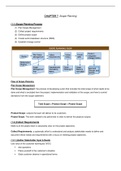Summary
Summary OBS220 Notes Covering Ch 7,8,11,14 PM (2022 Semester Test 2)
- Course
- Institution
- Book
Theses are detailed notes covering chapters 7,8,11, and 14 from the Project Management textbook. These notes have been compiled in conjunction with the textbook and lecture slides. These notes have also been made for semester test 2 of 2022. Textbook used: Project management: Kloppenborg, T.J.,...
[Show more]




